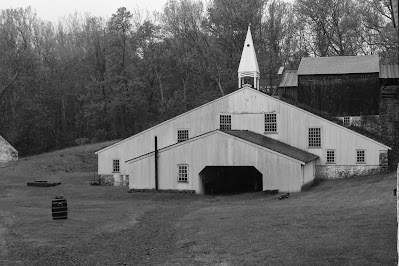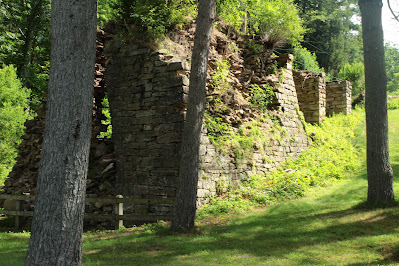Back in the 17th and 18th centuries one of our ancestors' needs was for good quality tools and to get these, they needed metal. The Pennsylvania hillsides have numerous fields of iron ore and to turn this ore into metal they built furnaces. By putting the ore into a furnace along with a couple other necessary ingredients, they were able to produce iron.
To remove the iron from the ore, it has to be heated extremely hot and then to separate the molten iron from the un-needed impurities a flux was needed. Limestone (and sometimes oyster shells) provided that element. For the heat the first furnaces were fueled by charcoal, made from the trees which grew around the furnace. Later, coal was used and then coke.
Furnaces were most often built where these main ingredients were located, saving the owners transportation costs. The charcoal was made by chopping down trees and stacking the logs in piles. The colliers, the men who made the charcoal would light these mounds and let them smolder. Their job, a rather dangerous one, was to make sure that the piles didn’t catch on fire. Woodcutters played a very important part of this process since it could take 300-350 acres of timber to keep a furnace in blast for a year! Once the charcoal had cooled it was put in a dry spot until it was needed, usually very close to the furnace. Iron ore and limestone were also brought to the site and kept close at hand.
The first iron furnace in Pennsylvania was the Colebrookdale Furnace on the outskirts of Boyertown, built in 1720. The first furnace west of the Alleghenies was the Alliance Furnace built in 1790, on Jacobs Creek, not far from Perryopolis. A furnace was built in Pittsburgh around 1792 but it lasted only a couple years before the ore ran out. The Shadyside Furnace was built where Shadyside is today, no evidence of it remains.
The early furnaces were built from field stone while later furnaces tended to have been built out of quarried and cut stone. The shapes were usually the same, square based, pyramidal shaped stacks of stone. There are some that were built in a round shape but these are rather rare. Some furnaces were built with tiers or ledges and the types of arches varied from furnace to furnace, some coming to a sharp point, some rounded and others squared off. I feel as if a lot of the design depended on what was available, the builders and owner’s egos, and how deep their pocket-books were!
Inside the furnace was the chimney, insulated from the outside by dirt and stones. Below that it widened out into the bosh where the molten ingredients combined. Below this was the crucible where the molten iron collected. There were arches on the sides, sometimes only one but usually two. Some furnaces had more. The one in the front was where the molten iron was allowed to flow out of into the molds on the casting room floor. Many furnaces also had a tuyere arch where air was blown into the furnace to increase the heat, producing better quality and more economic iron. Another arch may have been used to remove the slag from on top of the iron before it was tapped.
Slag was a byproduct of the iron making process that formed on top of the molten iron and had to be removed before the iron could be tapped. It hardened into a glassy mass that was easily broken and can be found near most of the old furnaces. The various colors of it are from the various chemicals and minerals used in the ingredients.
Air was introduced to the furnace by bellows which were operated by water wheels, powered by the near-by streams. This increased the heat of the furnace. In later years, some of these water wheels were replaced by steam engines. Like today, when a more efficient method was available, the company latched onto it. Progress always moves on!
When the stone blocking the crucible was removed, the molten iron would flow into the casting house, a sand floored room with molds tamped into the floor. A main line ran down from the furnace with branches coming off of it. The iron in the depressions was called pig iron because they resembled a sow feeding its piglets.
The land around a furnace was filled with various buildings to house equipment, workers and their shops.
The furnaces ran day and night, new ingredients were added after the furnace were tapped. It was a noisy, smoky place to live and work!
There were buildings for the charcoal, the iron and limestone, blacksmith and carpenter shops, stables for the horses and oxen used to transport raw materials and finished products, along with houses for the workers and their families. The workers houses were often log cabins, while the Ironmasters had much nicer residences. If it was a larger operation, schools and stores were near-by. The longer a furnace was in operation, the bigger its footprint would be.
Once the natural resources ran out or their prices increased beyond the owner’s means, the furnace went out of blast. Often it was because the lumber had run out. There are some furnaces that shut down because of poor quality ingredients. Some complexes continued producing iron for decades and a few, over 100 years!
The furnaces that went out of blast usually just sat there. Over time, the buildings were torn down or rotted away, the community that sat around the furnace often moved over to another furnace, the workers were needed there and commuting wasn’t a real option in those days. Some of the building which were better made might have survived but most just disappeared. The furnaces themselves, being made out of heavy stone tended to survive longer.
Trees and weeds start growing in between the stonework and as the years pass by, their roots increase in size, pushing the stonework apart and causing the structures to collapse. The weather: rain, snow and ice further erode the structures.
As decades turn into centuries, they collapse in on themselves and slowly disappear as nature grows up around them and hide them from view. Some furnaces were taken down and the stonework was used to build foundations for new buildings while some townships used them for walls and bridges.
Some of the furnaces were taken care of and some of the nicer ones were preserved. The growths on them were pruned off and historic societies, owners and sometimes state and federal governments made displays out of them. This requires time and money and some owners just can’t afford either and so the structures are left to the ravages of time.
This past week we took a trip to visit a couple furnaces we hadn’t seen yet. One, the Paradise Furnace was located near Raystown Lake in the Trough Creek State Park.
The furnace is near a small stream, built into a hillside. Stone pillars stand behind it on the hillside which held up a bridge which was used to carry ingredients to the top of the furnace for fueling. Time and gravity has pulled a lot of the furnace down. The right hand side is still standing but much of it is collapsing, exposing iron bars which helped hold it together. There are some signs near-by describing how furnaces worked but there was very little information about the furnace itself.
It was originally built around 1830 and was named the Trough Creek Furnace, in 1832 it was renamed the Mary Ann Furnace. It became the Paradise Furnace in 1843. It remained in blast until around 1860. The demand for iron during the Civil War had it re-fired in 1865, working until 1869.
About an hour away we came to the Franklin Furnace, a short distance away from Fort Laudon. This furnace was built in 1828, a couple years before the Paradise Furnace. It produced iron until 1882.
The walls of a period barn are sitting near-by as are the
manager’s house/office and a couple houses where the workers lived. There are no signs indicating that we
were in a historic district (as of 1991) or what the furnace was named or where
any of the historic houses were. The furnace was overgrown and had lawn
clippings and trash piled in front of it. The structure is still impressive but
sadly, we could have driven past it if we hadn’t been looking for it. It sits
about 40 feet from the road, looking abandoned and forgotten. I wonder if the
people in the neighborhood even realize or care that they live in a site that
was part of our state’s history.
These remnants of the iron industry are part of its beginning. They are part of the history of the steel industry and they are part of our country’s history. They helped make us as a country become who we are now! If you ever get a chance, visit one and see how far we’ve come!
Further Reading;
*Blair County Iron by Byron Smail (2024)
*Cornwall Iron Furnace, Pennsylvania Trail of History Guide by Susan Dieffenbach (2003)
*A Guide to the Old Stone Blast Furnaces in Western Pennsylvania by Myron B. Sharp & William H. Thomas (1966)
*Hopewell Furnace by National Park Service
*The Iron Furnaces of the Cove by Byron Smail (2023)
*The Iron Industry in Pennsylvania by Gerald G. Eggert (1994)
*Making Iron and Steel, The Historic Process 1700-1900 by Jack Chard (1995)
*Pennsylvania Iron Manufacture in the Eighteenth Century by Arthur Cecil Bining (1938)
* Study of Alternatives- Mount Etna Iron Furnace Complex by SW PA. Heritage Preservation Commission (1990)







%20at%20night.jpg)


1873%20.jpg)









.jpg)



1 comment:
Very interesting. I'm glad I got to visit a few furnaces with you
Post a Comment